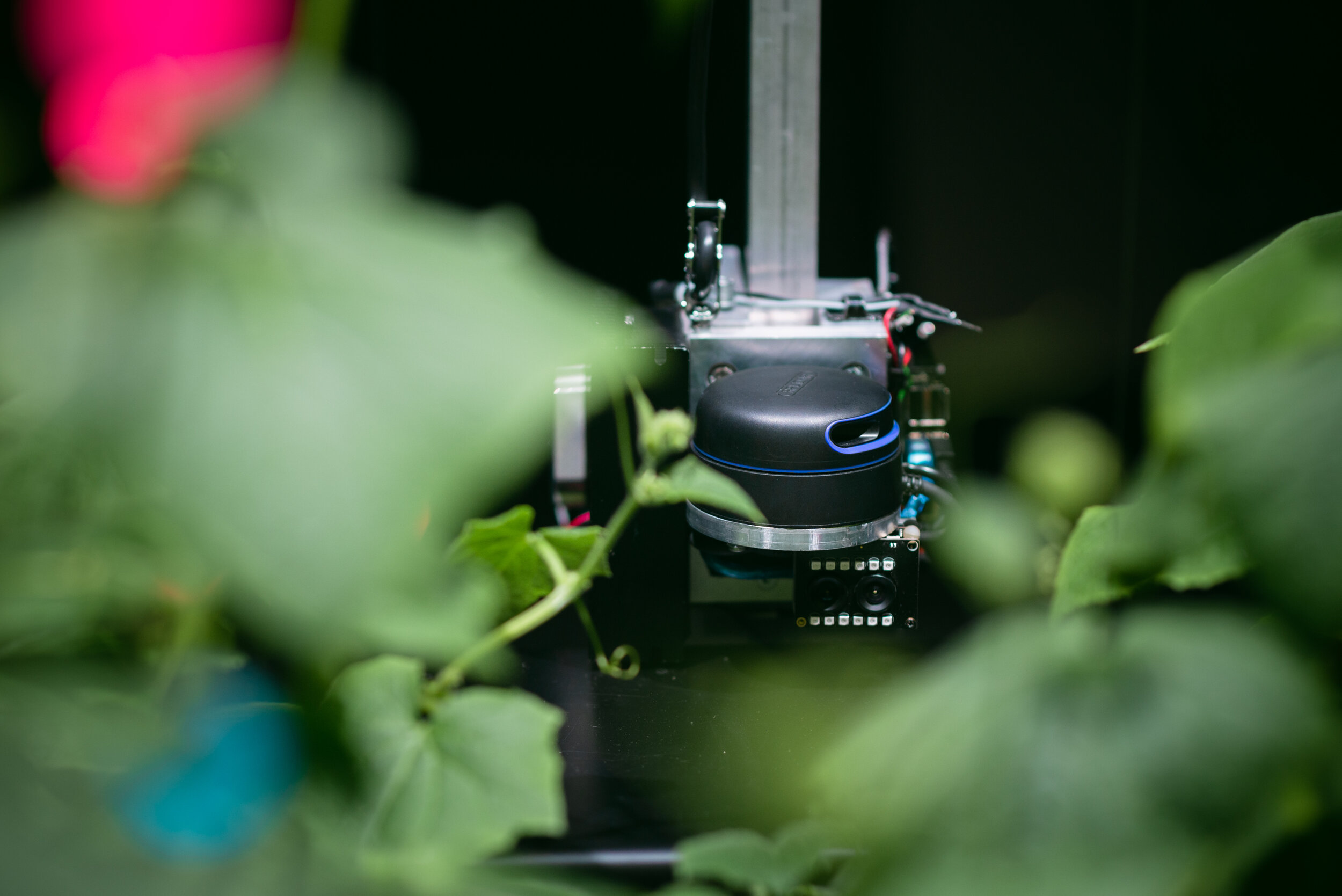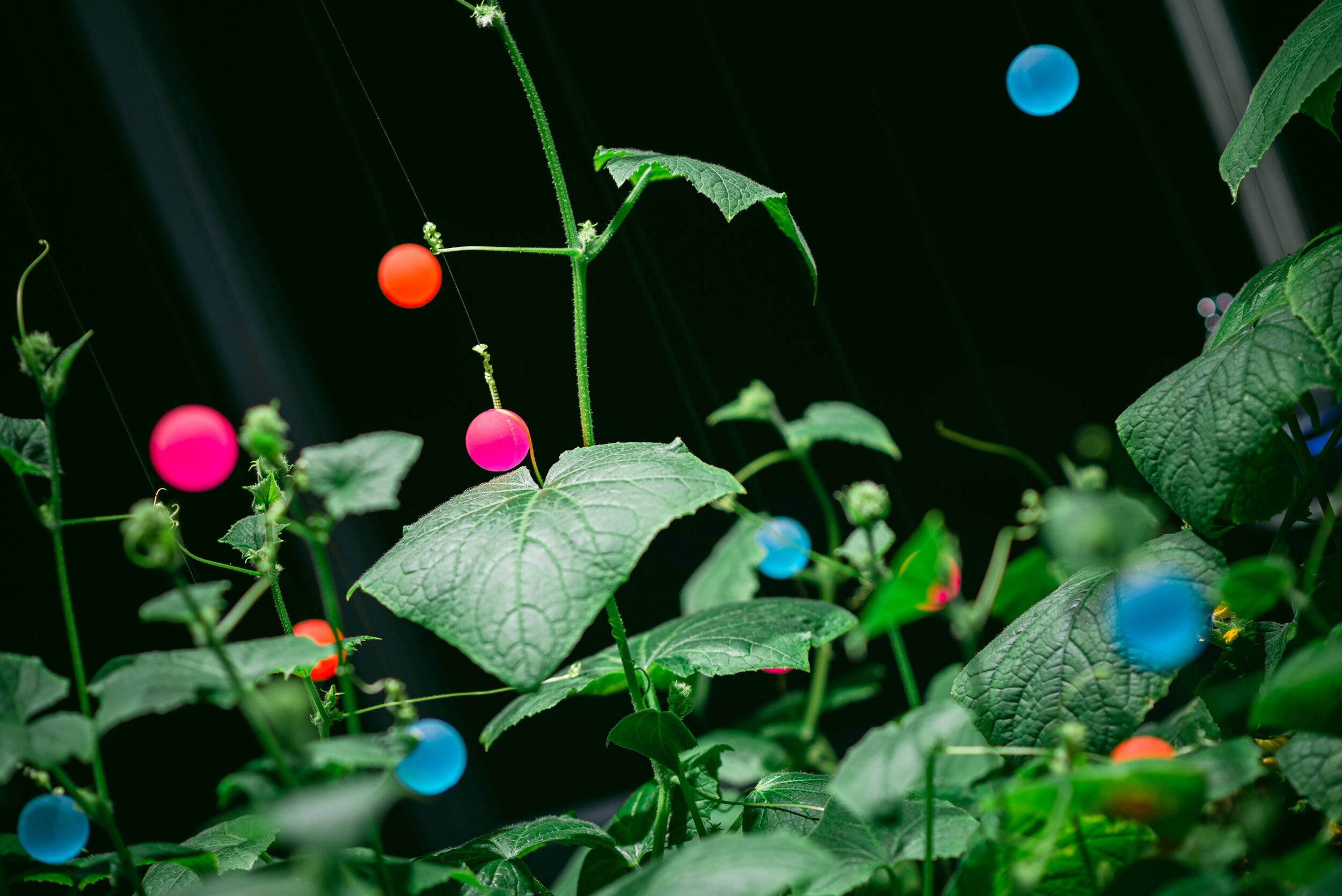Špela Petrič
Life in the terratope.
PL’AI, the third work from Špela Petrič’s opus PLANT-MACHINE, embraces the notion of a play as an ontological condition of all living bodies, including plants. The act of playing, unlike games, which are limited by clear rules or goals, reflects the curiosity of existence and is therefore at the heart of (self)knowing.
PL’AI is a process lasting several months in which plants grown from seed and an AI-robot whose perceptual world is limited to them, interact with each other. The play beyond the human time scale promises a glimpse of artificial intelligence as formed by the plant and, conversely, a morphology of the plant imprinted by the interventions of the robot.






Matters of Play – on the work of PL’AI by Špela Petrič
Agnieszka Anna Wołodźko, 2020
“I am not posthumanist, I am who become with companion species, who and which make a mess out of categories in the making of kin and kind, queer messmates in mortal play, indeed.”[1]
What if that which conditions our more-than-human bodies, are the relations of risky encounters, mutations, negotiations and transformations that cannot be universalised, cannot be categorised according to the rules and governance? What if what conditions our bodies are the relations of encounter that are intense, precarious and never exhausted by one definition? What if we do not know in advance what the implications of such relations are, what if all what we can do is to surrender, to embrace the encounters and continue to play within them? How the understanding and practice of such bodies would be like, and mostly, what would that entail?
The work of Špela Petrič PL’AI, embraces the notion of a play as such an ontological condition of bodies, where an act of play, unlike a game that has a clear set of rules and agents, becomes an expression of bodies - their way of living. Here, a play does not thus belong to human bodies alone, it is not bounded by the Anthropos, but belongs to any form of a living body, to any emanation of life regardless of how we now define it. As such, as an ontological condition of bodies that determines how bodies are and how they can possibly be, a play is not a product of culture, technologies, societies just as it does not serve any biological or physiological functions. A play, rather than having a purpose and being understood in term of a metaphor of the real, is practiced as an existential condition of our more than human bodies – a play allows bodies to thrive.
Johan Huizinga, a Dutch philosopher, analysed the notion of a play as an expression of bodies driven through a sheer joy and intensity that surpasses any moral, social and physical norms and functions. A play, as prior to culture, and yet as not bounded by biological and physiological constrains, was for him an expression of freedom. Through play, bodies step out from their own constrains, they surpass what is habituated as real, by creating their own temporality. As he maps, an etymology of the word play indicates its relation to enchantment, ritual, ceremony, erotic relationship and sexual intercourse. A play becomes thus denoting an act of encounter that is driven by desire, joy and yet is it risky and uncertain, because involves intimate porosity of relationship of bodies conditioned by it. To play is to “vouch or stand guaranty for, to take a risk, to expose oneself to danger for someone or something.”[2] In this way, a play means a relation of transformation happening, it is risky, because we do not know in advance how bodies will act, what will be the implications of their encounter, how they will change each other, influence their lives and materialities of their bodies. There are no rules when bodies play, and yet what conditions them is the desire for transformation, for continuing the act of play as transformation of the real – a desire for becoming with and becoming otherwise.
Donna Haraway, American biologist and philosopher, argued that a play “can occur only among those willing to risk letting go of the literal”[3] as play embodies the excess of bodies, the opening of the possibility of their transformation. The letting go of the literal, of the seriousness of the regime of the signification that monitor the accurateness in order to protect the borders and hierarchies governing the bodies, happens thus through the joy of transformations that play generates. Here, joy would not be simple fun, a signified moment of leisure protected by the clear indication of borders of the real. To be at play and to be conditioned by it becomes possible through the expression of joy as multiplication of relations of bodies and their temporalities. In play, we multiply through laughter as an expression of transformation happening before identification and categorization is even conceivable. Through the joy of play as laughter we express the possibility of becoming otherwise – we embrace the process of transformation. As she noted, a “play breaks rules to make something else happens,”[4] it becomes conditioning the possibility to live with the risk of an encounter that rather than constrains and govern, allows those bodies to reimagine and redefine themselves through each other, continuously. In a play, we are unmade and making, we are queer and queering identities and individuations, we resist autonomy by becoming contaminated by each other – we are affirming the process of becoming.
In her work, Petrič thus brings seemingly two unlikely bodies, a plant and an AI, into their encounter conditioned by a play. However, historically, a plant and a machine are not very much disattached from each other. Philosophers since Aristoteles, would refuse a plant to posses any agency or soul due to its seeming immovability, therefore allowing to perceive a plant as just a mechanic body. Rather than trying to dismantle and negate this systematic oppression and hierarchisation of bodies, Petrič, however, embraces a plant-machine companionship, their affinity and shared history of imaginings. Through play, we become witnessing the transformation of their constrains, opening up the possibility of their existence otherwise. We encounter the opening up of another temporeality, neither those of a plant, nor those of a machine alone, but both, already mutated by their needs and desires, and by our own implications into the expression of a possibility of their joy.
PL’AI is an expression of bodies in their shared struggles and desire to thrive, regardless of how risky and precarious the conditions are. Through PL’AI what is a plant, what is a machine, what is a human, what is a nonhuman blurs and overlaps – we become bodies laughing, embracing the joy of a play while becoming otherwise. The question is, how far can we transform each other in the act of play’s mutations? Are we ready to embrace the risk of change, to become with the plant-machine that PL’AI proposes?
[1] Donna J. Haraway, When Species Meet, Illustrated Edition (Minneapolis: Univ Of Minnesota Press, 2007), 19.
[2] Johan Huizinga, Homo Ludens: A Study of the Play-Element in Culture (Boston: The Beacon Press, 1964), 39.
[3] Haraway, When Species Meet, 239.
[4] Haraway, 238.
2020 | Author: Špela Petrič | Programming: Benjamin Fele, Tim Oblak | Robot development & assembly: Gregor Krpič, Erik Krkač, Jože Zajc, David Pilipovič | Hands-on assistance: Meta Petrič, Bor Jarh | Consulting: Adriana Knouf | Text: Agnieszka Wolodzko | Narration: Blaž Šef | Design: Miha Turšič | Photo & video: Hana Jošić | Thanks to: Andrej Petrič, Zoran Srdić-Janežič, Waag, MU Hybrid Art House | Produced by: Kersnikova Institute / Kapelica Gallery within the framework of the European ARTificial Intelligence Lab | Further development of the project: Smart Hybrid Forms | Co-funded by: Creative Europe Programme of the European Union, Ministry of Culture of the Republic of Slovenia, Ministry of Public Administration of the Republic of Slovenia, City of Ljubljana - Department of Culture, Creative Industries Fund NL
“Smart Hybrid Forms: A plant becomes a machine becomes a plant” is a project of Vrije Universiteit Amsterdam, Gerrit Rietveld Academy, Waag Society, V2_the lab for unstable media and Zone2Source and received the NWO ISA Smart Cultures grant with project no. CISC.KC.215.
